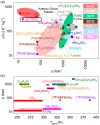Discovery of Colossal Breathing-Caloric Effect under Low Applied Pressure in the Hybrid Organic-Inorganic MIL-53(Al) Material
- PMID: 35444364
- PMCID: PMC9011131
- DOI: 10.1021/acs.chemmater.2c00137
Discovery of Colossal Breathing-Caloric Effect under Low Applied Pressure in the Hybrid Organic-Inorganic MIL-53(Al) Material
Abstract
In this work, "breathing-caloric" effect is introduced as a new term to define very large thermal changes that arise from the combination of structural changes and gas adsorption processes occurring during breathing transitions. In regard to cooling and heating applications, this innovative caloric effect appears under very low working pressures and in a wide operating temperature range. This phenomenon, whose origin is analyzed in depth, is observed and reported here for the first time in the porous hybrid organic-inorganic MIL-53(Al) material. This MOF compound exhibits colossal thermal changes of ΔS ∼ 311 J K-1 kg-1 and ΔH ∼ 93 kJ kg-1 at room temperature (298 K) and under only 16 bar, pressure which is similar to that of common gas refrigerants at the same operating temperature (for instance, p(CO2) ∼ 64 bar and p(R134a) ∼ 6 bar) and noticeably lower than p > 1000 bar of most solid barocaloric materials. Furthermore, MIL-53(Al) can operate in a very wide temperature range from 333 K down to 254 K, matching the operating requirements of most HVAC systems. Therefore, these findings offer new eco-friendly alternatives to the current refrigeration systems that can be easily adapted to existing technologies and open the door to the innovation of future cooling systems yet to be developed.
© 2022 The Authors. Published by American Chemical Society.
Conflict of interest statement
The authors declare the following competing financial interest(s): The use of the compounds studied in this work for breathing-caloric cooling/heating is covered in a recently filed patent application (P202130753) by J.G.-B., J.L-B., R.A., S.C.-G., M.A.S.-R., M.S.-A., and J.M.B.-G.
Figures








Similar articles
-
Empowering CO2 Eco-Refrigeration With Colossal Breathing-Caloric-Like Effects in MOF-508b.Adv Mater. 2024 Apr;36(16):e2310499. doi: 10.1002/adma.202310499. Epub 2023 Dec 25. Adv Mater. 2024. PMID: 38100276
-
Colossal Barocaloric Effect of Binary Fatty Acid Methyl Esters under Low Pressures near Room Temperature.J Phys Chem Lett. 2024 Feb 22;15(7):1962-1968. doi: 10.1021/acs.jpclett.3c03124. Epub 2024 Feb 12. J Phys Chem Lett. 2024. PMID: 38346261
-
Colossal barocaloric effects with ultralow hysteresis in two-dimensional metal-halide perovskites.Nat Commun. 2022 May 9;13(1):2536. doi: 10.1038/s41467-022-29800-9. Nat Commun. 2022. PMID: 35534457 Free PMC article.
-
Hydrogen storage methods.Naturwissenschaften. 2004 Apr;91(4):157-72. doi: 10.1007/s00114-004-0516-x. Epub 2004 Mar 17. Naturwissenschaften. 2004. PMID: 15085273 Review.
-
Materials with Giant Mechanocaloric Effects: Cooling by Strength.Adv Mater. 2017 Mar;29(11). doi: 10.1002/adma.201603607. Epub 2016 Dec 27. Adv Mater. 2017. PMID: 28026063 Review.
Cited by
-
Colossal Reversible Barocaloric Effects in a Plastic Crystal Mediated by Lattice Vibrations and Ion Diffusion.Adv Sci (Weinh). 2024 Jul;11(26):e2306488. doi: 10.1002/advs.202306488. Epub 2024 May 5. Adv Sci (Weinh). 2024. PMID: 38704680 Free PMC article.
-
Terahertz Spectroscopy Unambiguously Determines the Orientation of Guest Water Molecules in a Structurally Elusive Metal-Organic Framework.J Phys Chem Lett. 2024 May 23;15(20):5549-5555. doi: 10.1021/acs.jpclett.4c00706. Epub 2024 May 16. J Phys Chem Lett. 2024. PMID: 38753602 Free PMC article.
References
-
- IIF-IIR . Coulomb D.; Dupont J. L.; Pichard A.. International Institute of Refrigeration. https://iifiir.org/en/fridoc/the-role-of-refrigeration-in-the-global-eco... (accessed 2022–03–20), 29th Informatory Note on Refrigeration Technologies 2015 - The Role of Refrigeration in the Global Economy.
-
- Renewable Energy Division of the International Energy Agency (IEA) . International Energy Agency. https://www.iea.org/reports/renewables-2019 (accessed 2022–03–20), Renewables 2019 – Analysis and Forecast to 2024.
-
- Directorate of Sustainability, Technology and Outlooks (STO) and Directorate of Energy Markets and Security (EMS) of the International Energy Agency (IEA) . International Energy Agency. https://www.iea.org/reports/the-future-of-cooling (accessed 2022–03–20), The Future of Cooling Opportunities for Energy-Efficient Air Conditioning.
LinkOut - more resources
Full Text Sources
